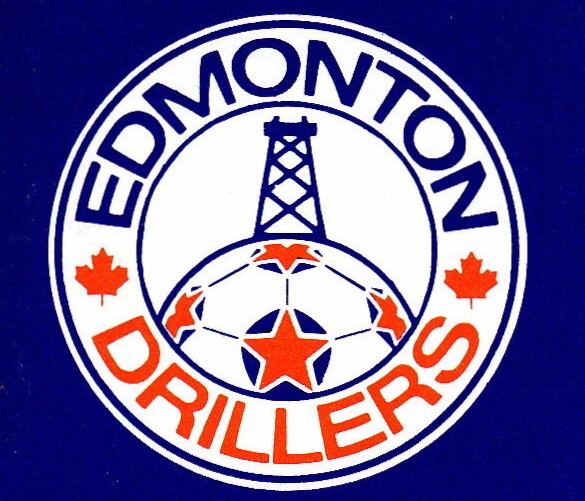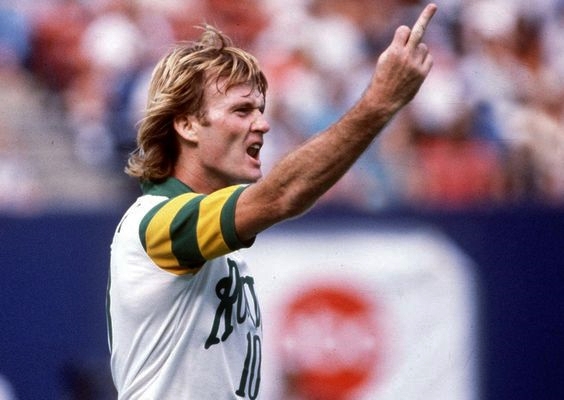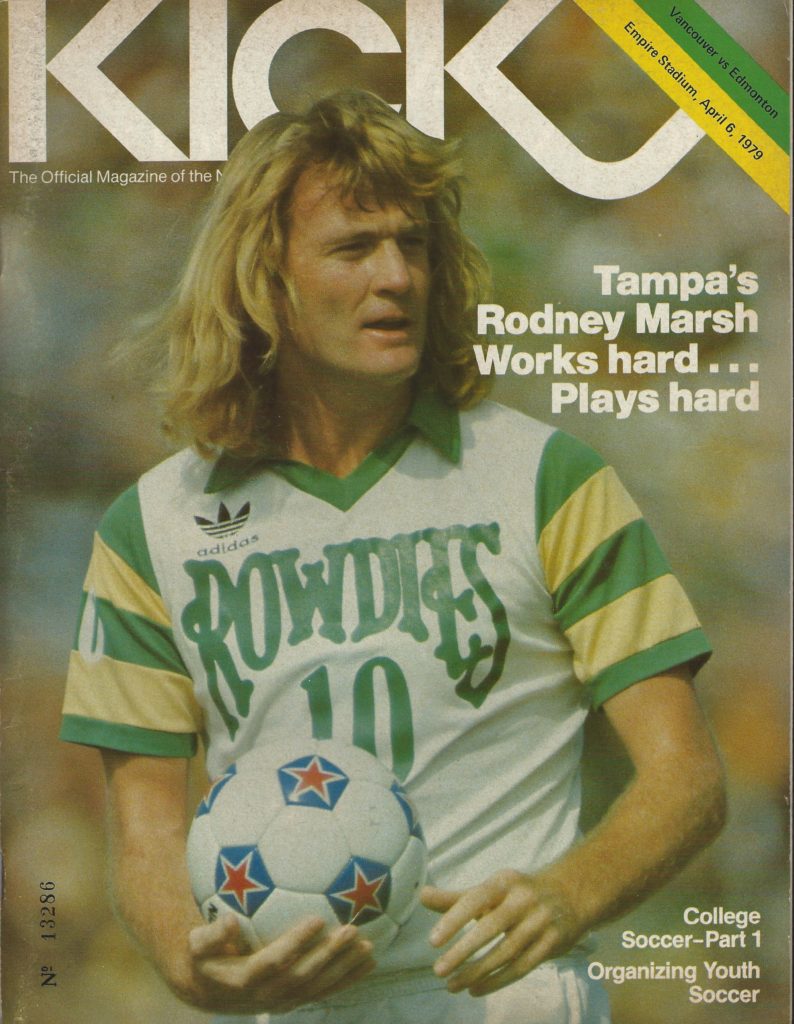Their Finest Hour: Vancouver Whitecaps 1979 Soccer Bowl winning season (Part Three – The first Canadian derby of the year, Carl Valentine, and Rodney Marsh)
Every week on AFTN from now until September 8th, we’ll be recapping the Whitecaps 1979 Soccer Bowl winning season with the help of matchday programs, photographs, and more. We’ll bring you all the highs, all the lows, and the all the wonder of their famous final victory, with a splattering of 1979 nostalgia and some interviews thrown in as well. It was different times people. Different times.
We kicked off our coverage last week with an overall season review and a look at the season opening loss to Dallas Tornado. The ‘Caps were keen to bounce back quickly from that 2-1 home defeat, and they didn’t have to wait long to do it.
One week after their season opener, the Whitecaps were at home again, and this time it was the first Canadian derby of the season.
Edmonton Drillers headed to Empire Stadium on Friday April 6th and a crowd of 19,097 was on hand to see what was a historic occasion.
This was Edmonton’s first season in the league, and not only was it the first meeting between the two new Canadian rivals, but it was the Drillers first ever league match. Edmonton were one of three Canadian teams in the NASL for the 1979 season, joining the Whitecaps and the Toronto Blizzard. But their stay in the league was brief, lasting only four seasons and they folded in 1982.
Perhaps unsurprising as this was the fourth incarnation of the side. From 1975 to 1977 they were first the Hartford Bicentennials and then the Connecticut Bicentennials, playing out of Hartford and then New Haven. With averages attendances of less than 4000 in each of their three seasons, the team was relocated to Oakland for the 1978 season, becoming the Stompers.
They drew an average attendance of 11,929 that season but that still wasn’t enough to keep them in California and the team was surprisingly sold to Edmonton businessman Peter Pocklington, who moved the team to Edmonton for the 1979 season, playing out of Commonwealth Stadium.
The Drillers only made the playoffs in one of their four seasons in the NASL (their second one in 1980), and falling attendances, poor media support, increasing running costs, and their desire to sign and thus pay for international players all combined to bring about their downfall. By their final season in the league in 1982, their average attendance was just 4,922, significantly down from their high of 10,920 just two years earlier.

The Drillers squad were an unknown quantity. Not only in terms of them being a “new” club but the fact that there weren’t a lot of well known players on their inaugural squad. Only four players from the Stompers roster from the previous season remained – two Yugoslavians, defender Joe Raduka and forward Bogdan Turudija, Croatian forward Mark Liveric, and Canadian defender Bruce Twamley.
Twamley was from Victoria, BC, and ended up being one of just four Canadian players on the Edmonton roster that season. The Drillers had a Dutchman as head coach, Hans Kraay, and he packed the squad with seven of his countrymen, along with seven players from other European countries.
Like Dallas the week before, Edmonton came to Empire to play a defensive game and to try and frustrate and stall a potent Vancouver attack.
It wasn’t as feisty a game as the season opener, and for all their own defensive play, the Whitecaps was even better, and they struggled to get much action in on Phil Parkes or his back four.
In the end the Drillers were undone by two defensive errors, allowing John Craven to head home the first Whitecaps goal from a Bob Bolitho corner, before Kevin Hector put away a Ray Lewington cross for the second and a 2-0 victory. That was Hector’s second in as many games and sent the fans home happy.
It wasn’t a great a performance overall, but it got the Whitecaps season off and running. Next up was their first away game of the season, with a trip to Chicago to face the Sting.
The Kick matchday magazine for the match was another packed 52 page affair, following the usual format. Every game saw a league-wide program issued with some local variations among the pages. That meant a lot of non Whitecaps articles for fans to read, which looking back on them now gives you a great insight into the league.
The Drillers program featured a wonderful shot of Tampa Bay Rowdies’ Rodney Marsh on the cover. Check out that hair! Anyone that knows of Marsh’s career, both over here and back in England, knows that he has plenty of wild tales to tell.
There’s a four page feature on Marsh where he promises that fans will see a new him this season off the pitch, but we’ll still see his “showbiz antics” on it, but admits that he’s a “different, controversial” figure, with the following telling quote.
“Incidents I get involved in turn out to make monumental news. On the front pages for days. If it’s other people (players), it means the inside pages. Mine carries on for weeks and weeks.”

Marsh had moved to North America in 1976, a year after suffering a nervous breakdown, to get away from the pressures of the game and the media spotlight back in the UK, where he was second only to George Best for headlines created. But he didn’t exactly escape controversy over here either, refusing to talk with reporters and slipping out of the back door from locker rooms.
He had also garnered ire the previous season when announcing on the morning of the 1978 Soccer Bowl that he wasn’t going to play because of an infection near his left shin. Team doctors said they would clear him, but he said no. The Rowdies lost 3-1 to New York Cosmos and Marsh was the figure to blame for many, by fans, pundits, and teammates. One year later, he was to line up facing the Whitecaps in the 1979 Soccer Bowl.
Marsh talks about his tough upbringing in Poplar, London and his “abrasive” father. It sounded tough. A lot of his childhood friends ended up in prison and he mentions that “you grew up to be one of three things – in a rock ‘n’ roll band, a soccer player, or a thief. And I can’t sing.”.
Left deaf in one ear following a collision with a goalpost when he was 18, Marsh reveals he lives to be an entertainer on the pitch, but feels “it’s no good entertaining the fans and not winning”, as he talks about wanting to coach the US national team in ten year’s time. That never happened, although he did coach the Rowdies for three years from 1984 to 1986.
It’s a fascinating read.
Other features in the program for this game were part two of a long running feature on improving youth soccer, this time concentrating on “basic organization”, an interview with designer Dick Martin who designed the iconic Whitecaps strip for the 1979 season (we’ll feature that in more detail separately another time), a feature on Edmonton’s Canadian midfielder Bruce Twamley, part one of a feature on college soccer, and all the usual stats and ads.
The Whitecaps player feature was of a man we all know very well – Carl Valentine. A man who will undoubtedly have his own wild tales to tell (it must be something about the hair back then), especially as his new roommate was Bruce Grobbelaar!
In the piece it explains that although new to Vancouver, 20-year-old Carl doesn’t feel homesick because of the warm welcome and friendliness he’s had from fans, something he still has to this day. The writer details his footballing career to date and feels that he “exudes quiet confidence” and is expected to be a key player for the team that season.
The article reveals that when Carl was 8-years-old his teacher took him off the school football team because his schoolwork was suffering, then explains “the move produced opposite results and the trauma was so great that two weeks later they put him back on the team rather than face the prospect that he would never do any work again!”.
Here’s some of our other favourite quotes from the article:
“Football has been my life… the only thing I have ever really concentrated on since I was 6 years old.”
“I like to think of myself as a player who can play any position, and I won’t be content to be just another player. I want to be a player who will be remembered.”
That he certainly achieved in Vancouver.

Read Further on AFTN.ca
Every week on AFTN from now until September 8th, we’ll be recapping the Whitecaps 1979 Soccer Bowl winning season with the help of matchday programs, photographs, and more. We’ll bring you all the highs, all the lows, and the all the wonder of their famous final victory, with a splattering of 1979 nostalgia and some interviews thrown in as well. It was different times people. Different times.
We kicked off our coverage last week with an overall season review and a look at the season opening loss to Dallas Tornado. The ‘Caps were keen to bounce back quickly from that 2-1 home defeat, and they didn’t have to wait long to do it.
One week after their season opener, the Whitecaps were at home again, and this time it was the first Canadian derby of the season.
Edmonton Drillers headed to Empire Stadium on Friday April 6th and a crowd of 19,097 was on hand to see what was a historic occasion.
This was Edmonton’s first season in the league, and not only was it the first meeting between the two new Canadian rivals, but it was the Drillers first ever league match. Edmonton were one of three Canadian teams in the NASL for the 1979 season, joining the Whitecaps and the Toronto Blizzard. But their stay in the league was brief, lasting only four seasons and they folded in 1982.
Perhaps unsurprising as this was the fourth incarnation of the side. From 1975 to 1977 they were first the Hartford Bicentennials and then the Connecticut Bicentennials, playing out of Hartford and then New Haven. With averages attendances of less than 4000 in each of their three seasons, the team was relocated to Oakland for the 1978 season, becoming the Stompers.
They drew an average attendance of 11,929 that season but that still wasn’t enough to keep them in California and the team was surprisingly sold to Edmonton businessman Peter Pocklington, who moved the team to Edmonton for the 1979 season, playing out of Commonwealth Stadium.
The Drillers only made the playoffs in one of their four seasons in the NASL (their second one in 1980), and falling attendances, poor media support, increasing running costs, and their desire to sign and thus pay for international players all combined to bring about their downfall. By their final season in the league in 1982, their average attendance was just 4,922, significantly down from their high of 10,920 just two years earlier.

The Drillers squad were an unknown quantity. Not only in terms of them being a “new” club but the fact that there weren’t a lot of well known players on their inaugural squad. Only four players from the Stompers roster from the previous season remained – two Yugoslavians, defender Joe Raduka and forward Bogdan Turudija, Croatian forward Mark Liveric, and Canadian defender Bruce Twamley.
Twamley was from Victoria, BC, and ended up being one of just four Canadian players on the Edmonton roster that season. The Drillers had a Dutchman as head coach, Hans Kraay, and he packed the squad with seven of his countrymen, along with seven players from other European countries.
Like Dallas the week before, Edmonton came to Empire to play a defensive game and to try and frustrate and stall a potent Vancouver attack.
It wasn’t as feisty a game as the season opener, and for all their own defensive play, the Whitecaps was even better, and they struggled to get much action in on Phil Parkes or his back four.
In the end the Drillers were undone by two defensive errors, allowing John Craven to head home the first Whitecaps goal from a Bob Bolitho corner, before Kevin Hector put away a Ray Lewington cross for the second and a 2-0 victory. That was Hector’s second in as many games and sent the fans home happy.
It wasn’t a great a performance overall, but it got the Whitecaps season off and running. Next up was their first away game of the season, with a trip to Chicago to face the Sting.
The Kick matchday magazine for the match was another packed 52 page affair, following the usual format. Every game saw a league-wide program issued with some local variations among the pages. That meant a lot of non Whitecaps articles for fans to read, which looking back on them now gives you a great insight into the league.
The Drillers program featured a wonderful shot of Tampa Bay Rowdies’ Rodney Marsh on the cover. Check out that hair! Anyone that knows of Marsh’s career, both over here and back in England, knows that he has plenty of wild tales to tell.
There’s a four page feature on Marsh where he promises that fans will see a new him this season off the pitch, but we’ll still see his “showbiz antics” on it, but admits that he’s a “different, controversial” figure, with the following telling quote.
“Incidents I get involved in turn out to make monumental news. On the front pages for days. If it’s other people (players), it means the inside pages. Mine carries on for weeks and weeks.”

Marsh had moved to North America in 1976, a year after suffering a nervous breakdown, to get away from the pressures of the game and the media spotlight back in the UK, where he was second only to George Best for headlines created. But he didn’t exactly escape controversy over here either, refusing to talk with reporters and slipping out of the back door from locker rooms.
He had also garnered ire the previous season when announcing on the morning of the 1978 Soccer Bowl that he wasn’t going to play because of an infection near his left shin. Team doctors said they would clear him, but he said no. The Rowdies lost 3-1 to New York Cosmos and Marsh was the figure to blame for many, by fans, pundits, and teammates. One year later, he was to line up facing the Whitecaps in the 1979 Soccer Bowl.
Marsh talks about his tough upbringing in Poplar, London and his “abrasive” father. It sounded tough. A lot of his childhood friends ended up in prison and he mentions that “you grew up to be one of three things – in a rock ‘n’ roll band, a soccer player, or a thief. And I can’t sing.”.
Left deaf in one ear following a collision with a goalpost when he was 18, Marsh reveals he lives to be an entertainer on the pitch, but feels “it’s no good entertaining the fans and not winning”, as he talks about wanting to coach the US national team in ten year’s time. That never happened, although he did coach the Rowdies for three years from 1984 to 1986.
It’s a fascinating read.
Other features in the program for this game were part two of a long running feature on improving youth soccer, this time concentrating on “basic organization”, an interview with designer Dick Martin who designed the iconic Whitecaps strip for the 1979 season (we’ll feature that in more detail separately another time), a feature on Edmonton’s Canadian midfielder Bruce Twamley, part one of a feature on college soccer, and all the usual stats and ads.
The Whitecaps player feature was of a man we all know very well – Carl Valentine. A man who will undoubtedly have his own wild tales to tell (it must be something about the hair back then), especially as his new roommate was Bruce Grobbelaar!
In the piece it explains that although new to Vancouver, 20-year-old Carl doesn’t feel homesick because of the warm welcome and friendliness he’s had from fans, something he still has to this day. The writer details his footballing career to date and feels that he “exudes quiet confidence” and is expected to be a key player for the team that season.
The article reveals that when Carl was 8-years-old his teacher took him off the school football team because his schoolwork was suffering, then explains “the move produced opposite results and the trauma was so great that two weeks later they put him back on the team rather than face the prospect that he would never do any work again!”.
Here’s some of our other favourite quotes from the article:
“Football has been my life… the only thing I have ever really concentrated on since I was 6 years old.”
“I like to think of myself as a player who can play any position, and I won’t be content to be just another player. I want to be a player who will be remembered.”
That he certainly achieved in Vancouver.

Read Further on AFTN.ca